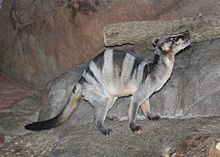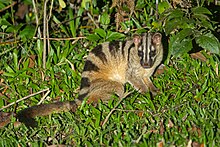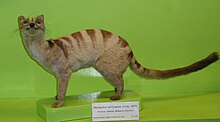Banded palm civet
| Banded palm civet | |
|---|---|
 | |
| A banded palm civet in the Cincinnati Zoo | |
| Scientific classification | |
| Domain: | Eukaryota |
| Kingdom: | Animalia |
| Phylum: | Chordata |
| Class: | Mammalia |
| Order: | Carnivora |
| Suborder: | Feliformia |
| Family: | Viverridae |
| Genus: | Hemigalus Jourdan, 1837 |
| Species: | H. derbyanus[1] |
| Binomial name | |
| Hemigalus derbyanus[1] (Gray, 1837) | |
| Subspecies[3] | |
| |
 | |
| Banded palm civet range | |
| Synonyms | |
| Paradoxurus derbyanus[1] | |
The banded palm civet (Hemigalus derbyanus[a]), also called the banded civet, is a viverrid native to Indomalaya. They primarily inhabit lowland conifer habitat, which is under threat from encroaching human activity. It is estimated the population of the banded palm civet has decreased by around 30% in just three generations. Banded palm civets are usually approximately the size of a domestic cat; their fur is pale but with dark bands on the back. They are believed to be closely related to Hose's palm civets, which are similar in appearance and distribution.
The banded palm civet is the only species in its genus, first scientifically described in 1837. The species comprises four subspecies, distributed across Indonesia and Southeast Asia. Two of the subspecies diverged from each other as long ago as 2.7 million years.
Banded palm civets are affected by a variety of parasites, such as nematodes, and are primarily carnivorous, eating small animals such as rodents and bugs. They have sensitive hairs on their paws which help them to detect potential prey.
Classification[edit]
The genus Hemigalus was named and first described in 1837 by Claude Jourdan who had a skin and skeleton of one zoological specimen at his disposal.[5] In the same year, John Edward Gray described a specimen from the Malay Peninsula under the names Paradoxurus derbyanus and Paradoxurus derbianus.[6][7] In 1939, Reginald Innes Pocock subordinated banded palm civet specimens described between 1837 and 1915 under the genus Hemigalus and recognised that it is a monotypic taxon.[8] The genus name is derived from the Greek hemi (half) and galus (weasel), due to its appearance.[4][better source needed]
The species is believed to be closely related to Hose's palm civet – another species of civet in the subfamily Hemigalinae, also distributed in Southeast Asia, and with a similar build and appearance.[9]
Subspecies[edit]
There are four subspecies: H. derbyanus derbyanus, H. d. boiei, H. d. minor, and H. d. sipora. H. d. derbyanus is known from Myanmar and mainland Malaysia as well as Sumatra; H. d. boiei is known only from Borneo; H. d. minor, from South Pagai and the Mentawai islands; and H. d. sipora, from Sipora and the Mentawai islands. There is also a population on Siberut island, but it has not been attributed to any subspecies.[3]
It is estimated that H. d. minor and H. d. derbyanus diverged from each other some 2.7 million years ago.[10]
Description[edit]

The banded palm civet's fur is usually pale in colour, and they have between seven and eight dark bands on their face and on their back.[11][12] The pale colour is typically pale brown, grey, whitish or buff, but can also be yellowish; the bands are usually dark brown, black, or chestnut in colour.[8][13] It is roughly the size of domestic cat, growing up to 53 cm (21 in) in length – minus the tail – and weighing from 1–3 kg (2.2–6.6 lb).[4] The tail is usually three-quarters the length of the body and head combined,[8] and appear to swell in size in response to a threat. It has sensitive hairs in between the pads of its paws for sensing prey.[12]
Distribution and habitat[edit]
The banded palm civet is native to Myanmar, Thailand, Peninsular Malaysia, Sumatra, the Mentawai Islands and Borneo from sea level up to an elevation of 1,660 m (5,450 ft).[2]
In Myanmar, only two individuals were recorded between the early 20th century and the 1960s, both in the far south.[14] In 2022, it was photographed by a camera trap for the first time in a reserved forest in Tanintharyi Region.[15] In Thailand, it was photographed during camera trap surveys in the years 1996–2013 in Khlong Saeng Wildlife Sanctuary, Khao Sok National Park, Kui Buri National Park and Hala-Bala Wildlife Sanctuary, all in evergreen forests at elevations of 162–695 m (531–2,280 ft).[16] In Peninsular Malaysia, it was recorded in just two locations during surveys in 2011–2012 in a hilly dipterocarp forest in Terengganu.[17]
In Sumatra, it was recorded at an elevation of 150 m (490 ft) in primary forest in Kerinci Seblat National Park and on the west coast also at 800 m (2,600 ft).[18] In Bukit Barisan Selatan National Park, it was photographed in primary evergreen forest at the elevation of 800–1,089 m (2,625–3,573 ft) in 2011.[19] In South Solok Regency, it was recorded in forest fragments within an oil palm plantation adjacent to Kerinci Seblat National Park in 2015.[20]
It was extirpated in Singapore in the early 20th century.[12]
Behaviour and ecology[edit]

The banded palm civet is nocturnal and spends the day in low tree holes.[4] It is thought to be a solitary animal.[9] Its activity pattern overlaps with two other species of civet, rodents, as well as the clouded leopard – a potential predator.[12]
In response to a predator or other threat, banded palm civets swell their tails.[12]
Diet[edit]
The banded palm civet is a strict carnivore and preys on a variety of small animals, including crustaceans, ants, spiders, worms, rats, frogs, small reptiles and birds.[12] It occasionally feeds on vegetation and fruits.[12] Twelve scat samples contained worms, orthopterans and invertebrates.[21]
Banded palm civets hunt around water or along the forest floor.[4] To attack large prey, the civets bite the back of the victim's neck and then shake vigorously, then hold their victim with their front paws, allowing them to attack with their teeth.[22]
Reproduction[edit]

Females have one or two litters a year with one or two young. The gestation period varies from 32 to 64 days.[22] Data from the wild suggests they usually live up to twelve years of age, although one civet taken into captivity is recorded having lived for eighteen years.[21] The newborns weigh as little as 125 g (4.4 oz) and usually first open their eyes eight to twelve days after being born. They typically nurse for up to 70 days.[22]
The generation length of the banded palm civet is five years.[2]
Health[edit]
Analysis of the gut content of two banded palm civet roadkills in northern Borneo revealed a variety of parasites, including nematodes, eggs of trematodes, mites and pinworms.[23]
Threats[edit]
The major threat to the banded palm civet is loss and destruction of natural habitat loss by logging and subsequent conversion to agriculture, plantations and construction of dams. It is hunted and eaten by local people in Sabah.[2] Its preferred habitat, lowland forest, is particularly prone to such threats.[9] In 2016, the population was thought to have declined by 30% over just three generations.[24] In 2022, it was estimated that the population has declined to just 21% of the IUCN Red List distribution.[12]
Some humans take them from their natural habitat to keep them as pets.[25]
Conservation[edit]
The banded palm civet is listed as Near Threatened on the IUCN Red List, and the global population is thought to be decreasing. It is protected under CITES' Appendix II.[2] About 24% of its estimated range is in protected areas.[9] but a later (2022) study estimated that value to be only 12%.[12]
Notes[edit]
- ^ Indonesian: Musang Belang[4]
References[edit]
- ^ a b Wozencraft, W. C. (2005). "Species Hemigalus derbyanus". In Wilson, D. E.; Reeder, D. M. (eds.). Mammal Species of the World: A Taxonomic and Geographic Reference (3rd ed.). Johns Hopkins University Press. pp. 532–628. ISBN 978-0-8018-8221-0. OCLC 62265494.
- ^ a b c d e f Ross, J.; Brodie, J.; Cheyne, S.; Chutipong, W.; Hedges, L.; Hearn, A.; Linkie, M.; Loken, B.; Mathai, J.; McCarthy, J.; Ngoprasert, D.; Tantipisanuh, N.; Wilting, A.; Haidir, I.A. (2015). "Hemigalus derbyanus". IUCN Red List of Threatened Species. 2015: e.T41689A45216918. doi:10.2305/IUCN.UK.2015-4.RLTS.T41689A45216918.en. Retrieved 24 January 2022.
- ^ a b Veron, G.; Bonillo, C.; Hassanin, A. & Jennings, A. P. (2017). "Molecular systematics and biogeography of the Hemigalinae civets (Mammalia, Carnivora)". European Journal of Taxonomy (285). doi:10.5852/ejt.2017.285. S2CID 90409859.
 This article incorporates text from this source, which is available under the CC BY 3.0 license.
This article incorporates text from this source, which is available under the CC BY 3.0 license. - ^ a b c d e "Wildlife of RER: Banded Palm Civet". 2021. Retrieved 2023-08-16.
- ^ Jourdan, C. (1837). "Mémoire sur deux mammifères nouveaux de l'Inde, considérés comme types des deux genres voisins des Paradoxures, genres Hémigale et Ambliodon". Comptes rendus hebdomadaires des séances de l'Académie des sciences: 442–447.
- ^ Gray, J.E. (1837). "Description of some new and little known Mammalia, principally in the British Museum collection". Magazine of Natural History. 1 (November): 577–587.
- ^ Gray, J.E. (1837). "On a new species of Paradoxure (Paradoxurus Derbianus), with remarks on some Mammalia recently purchased by the British Museum, and characters of the new species". Proceedings of the Zoological Society of London. V: 67.
- ^ a b c Pocock, R. I. (1939). "Hemigalus". The fauna of British India, including Ceylon and Burma. Vol. Mammalia. – Volume 1. London: Taylor and Francis. pp. 452–458.
- ^ a b c d Jennings, A. P.; Mathai, J.; Brodie, J.; Giordano, A. J. & Veron, G. (2013). "Predicted distributions and conservation status of two threatened Southeast Asian small carnivores: the banded civet and Hose's civet". Mammalia. 77 (3): 261–271. doi:10.1515/mammalia-2012-0110. S2CID 84601364.
- ^ Wilting, A.; Sollmann, R.; Meijaard, Erik; Helgen, K. M. & Fickel, J. (2012). "Mentawai's endemic, relictual fauna: is it evidence for Pleistocene extinctions on Sumatra?: Mentawai's fauna indicates extinctions on Sumatra" (PDF). Journal of Biogeography. 39 (9): 1608–1620. doi:10.1111/j.1365-2699.2012.02717.x. S2CID 86165258.
- ^ Tanomtong, A.; Khunsook, S.; Seatung, N.; Supanuam, P.; Kenthao, A. & Kaewsri, S. (2011). "Chromosome studies in the Banded Palm Civet, Hemigalus derbyanus Thomas, 1915 (Carnivora, Viverridae) by conventional staining, GTG-Banding and high-resolution techniques". Cytologia. 76 (1): 89–97. doi:10.1508/cytologia.76.89.
- ^ a b c d e f g h i Dunn, A.; Amir, Z.; Decoeur, H.; Dehaudt, B.; Nursamsi, I.; Mendes, C.; Moore, J. H.; Negret, P. J.; Sovie, A. & Luskin, M. S. (2022). "The ecology of the banded civet (Hemigalus derbyanus) in Southeast Asia with implications for mesopredator release, zoonotic diseases, and conservation". Ecology and Evolution. 12 (5): e8852. Bibcode:2022EcoEv..12E8852D. doi:10.1002/ece3.8852. PMC 9047978. PMID 35505997.
- ^ Veron, G.; Laidlaw, R.; Rosenthal, S. H.; Streicher, U. & Roberton, S. (2004). "Coat colour variation in the banded palm civet Hemigalus derbyanus and in Owston's civet Chrotogale owstoni". Mammal Review. 34 (4): 307–310. doi:10.1111/j.1365-2907.2004.00047.x.
- ^ Than Zaw; Saw Htun; Saw Htoo Tha Po; Myint Maung; Lynam, A. J.; Kyaw Thinn Latt; Duckworth, J. W. (2008). "Status and distribution of small carnivores in Myanmar". Small Carnivore Conservation. 38: 2–28.
- ^ Thu, A. M.; Phyo, A. M. & Quan, R. C. (2023). "First camera-trap evidence of banded civet Hemigalus derbyanus (Mammalia: Carnivora: Viverridae) in Myanmar". Mammalia. 87 (2): 158–161. doi:10.1515/mammalia-2022-0035. S2CID 254295093.
- ^ Chutipong, W.; Tantipisanuh, N.; Ngoprasert, D.; Lynam, A. J.; Steinmetz, R.; Jenks, K.E.; Grassman Jr., L.I.; Tewes, M.; Kitamura, S.; Baker, M. C.; McShea, W.; Bhumpakphan, N.; Sukmasuang, R.; Gale, G. A.; Harich, F. K.; Treydte, A. C.; Cutter, P.; Cutter, P. B.; Suwanrat, S.; Siripattaranukul, K.; Hala-Bala Wildlife Research Station, Wildlife Research Division & Duckworth, J. W. (2014). "Current distribution and conservation status of small carnivores in Thailand: a baseline review". Small Carnivore Conservation. 51: 96–136.
- ^ Hedges, L.; Clements, G. R.; Aziz, S.A.; Yap, W.; Laurance, S.; Goosem, M. & Laurance, W. F. (2013). "Small carnivore records from a threatened habitat linkage in Terengganu, Peninsular Malaysia". Small Carnivore Conservation. 49: 9–14.
- ^ Holden, J. (2006). "Small carnivores in central Sumatra". Small Carnivore Conservation. 34 & 35: 35–38.
- ^ McCarthy, J. L. & Fuller, T. K. (2014). "Records of small carnivores from Bukit Barisan Selatan National Park, southern Sumatra, Indonesia". Small Carnivore Conservation. 51: 59–63.
- ^ Solina, I. D.; Novarino, W.; Rizaldi, G. A. & Giardino, A. J. (2018). "Activity pattern and habitat profile of small carnivores in an oil palm landscape". Journal of Indonesian Natural History. 6: 18–27.
- ^ a b Nowak, R. M. (2005). Walker's Carnivores of the World. JHU Press. ISBN 978-0-8018-8032-2.
- ^ a b c Santoro, K. "Hemigalus derbyanus (banded palm civet)". Animal Diversity Web. Retrieved 2023-12-31.
- ^ Colon, C. & Patton, S. (2012). "Parasites of civets (Mammalia, Viverridae) in Sabah, Borneo: A coprological survey". Malayan Nature Journal. 64 (2): 87–94.
- ^ Ross, J.; Hearn, A.; MacDonald, D. W.; Semiadi, G.; Alfred, R.; Mohamed, A.; Brodie, J. F.; Giordano, A.; Heydon, M.; Hon, J.; Rustam; Mathai, J.; Fredriksson, G.; Boonratana, R.; Loken, B.; Marshall, A. J.; van Berkel, T.; Lim, N. T-L.; Cheyne, S. M.; Belant, J. L.; Kramer-Schadt, S. & Wilting, A. (2016). "Predicted distribution of the banded civet Hemigalus derbyanus (Mammalia: Carnivora: Viverridae) on Borneo" (PDF). Raffles Bulletin of Zoology. Supplement (33): 111–117.
- ^ "Banded palm civet". indonesia.wcs.org. Retrieved 2023-08-17.


 French
French Deutsch
Deutsch